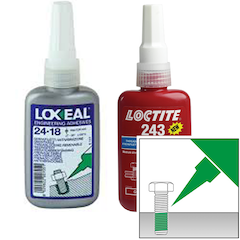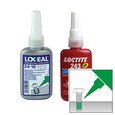What is threadlocker?

Figure 1: Threadlocker
A threadlocker is an adhesive for nuts, bolts, and screws to lock them in place and avoid loosening caused by stress and vibration. They replace traditional mechanical washers and fasteners. They are anaerobically curing chemicals that form a strong film in the gaps between the thread of the connection, locking it in place. Threadlockers are available in different versions with different curing times, maximum strength, and temperature ranges. Read our Loctite threadlocker color explanation article to learn more about Loctite products. Read our sealing and adhesives overview article for all different types of sealants and adhesive products.
View our online selection of threadlockers!
Table of Contents
- Threadlocker properties
- Selection guide
- Common applications
- How do you apply threadlocker?
- How do you remove threadlocker?
- FAQ
Threadlocker properties
They should exhibit the following properties:
- Faster cure speed at room temperature.
- Chemical compatibility with acids, alkalis, and solvents.
- Vibration resistance
- Good consistency for even application.
Selection guide
Consider the following criteria when selecting a threadlocker for your application:
- Media: The media coming in contact with the threadlocker should be chemically compatible.
- Curing speed: The full curing time of the threadlocker usually takes about 24 to 36 hours, whereas the handling cure time can be 1.5 to 30 minutes depending on the type and strength of the threadlocker.
- Approvals: Threadlockers come with different approvals for use in different applications. Low strength Loxeal threadlocker and high strength Loctite threadlockers are available with gas application approval. ANSI/ NSF certifications are for drinking water and food-grade applications.
- Temperature: Temperature can affect the performance of the threadlocker. High-temperature threadlockers are available to use for high-temperature applications.
-
Torque: There are low, medium, and high strength threadlocker available depending upon the use. Use a medium strength threadlocker if it may need to be disassembled in the future. High strength threadlockers are suitable for applications that do not require breaking the seal in the future.
- Low-strength: Can be disassembled with force.
- Medium-strength: Can be disassembled with high force.
- High-strength: Are considered permanently locked and can only be removed using specialized chemicals.
Threadlocker chart
The following chart provides information on different brands, strengths, and specifications:
| Strength | Brand | Color | Max Thread Size | Cure Speed (handling cure speed/ full cure speed)* | Temperature range (°C) | Breaking Torque (Nm) | Viscosity (+25°C - mPa s) | Approval |
| Low Strength | Loxeal | Purple | M24 | 15-30 mins/ 24-36 hrs | -55 to 150 | 5 to 8 | 800 - 1400 | Gas |
| Loctite | Purple | M36 | 10-300 min/3-72 hrs | -55 to 150 | 4 to 14 | 900 - 1500 | - | |
| Medium Strength | Loctite | Blue | M36 | 5-30 mins/0.5-72 hrs | -55 to 180 | 5 to 25 | 1300 - 3000 | - |
| Loctite (Wax Stick) | Blue | M50 | 15 mins/4-72 hrs | -55 to 150 | 8 to 32 | - | - | |
| High Strength | Loxeal | Green | M5 | 10-20mins/ 24-36 hrs | -55 to 150 | 11 to 25 | 10 - 20 | - |
| Loxeal | Green | M20 | 10-20mins/ 24-36 hrs | -55 to 200 | 25 to 35 | 450 - 650 | - | |
| Loxeal | Green | M25 | 10-20mins/ 24-36 hrs | -55 to 200 | 25 to 35 | 450 - 650 | - | |
| Loctite | Green | M6 | 15 – 60 mins/3-6 hrs | -55 to 150 | 10 to 40 | 20 - 55 | - | |
| Loctite | Green | M20 | 5 - 30 mins/3-72 hrs | -55 to 150 | 5 to 46 | 400 - 600 | Gas | |
| Loctite | Green | M20 | 5 - 30 mins/3-72 hrs - | -55 to 180 | 5 to 46 | 400 - 600 | - | |
| High Strength | Loctite (Wax Stick) | Red | M50 | 5 min/ 8 – 168 hrs | -55 to 150 | 10 to 50 | - | - |
| Loctite | Red | M80 | 5 – 60 min/1 – 72 hrs | -55 to 200 | 23 to 30 | 4000 - 15000 | - |
*medium dependent
Common applications
A wide range of industrial and residential applications use threadlockers. Some applications include:
- Water pipeline assemblies
- Gas line assemblies
- Automotive maintenance
- Aerospace assemblies
How do you apply threadlocker?
The following steps are involved when applying a threadlocker:
- Make sure the surface is clean, dry, and free of grease.
- Choose the correct threadlocker type according to the application.
- Apply the threadlocker evenly throughout the thread surface.
- Assemble the fastener and leave for curing.
How do you remove threadlocker?
The following steps are involved in removing the threadlocker:
- Heat the fastener for a couple of minutes.
- Use a hand or wrench to remove the bolt.
- If applying a new threadlocker, clean the bolt and apply the new threadlocker to the threads and reinstall.
You can learn more about wrenches in our wrench buying guide.
FAQ
What is threadlocker?
Threadlocker is an adhesive used to lock bolts, studs, nuts, and screws and prevent accidental loosening of the fasteners due to exposure to stress and vibration.
How to use threadlocker?
To apply the threadlocker, apply a small amount on the thread of the fastener before installation. Once it is dry, it will form a bond and hold the fastener in place even when exposed to vibrations.
Is threadlocker glue?
The threadlocker can be used as a glue. However, the adhesive bond may differ for different types of threadlockers. Blue, green, red, purple, yellow color-coded threadlockers are available, with each having different adhesive strength.
Is threadlocker permanent?
Red or green threadlocker (high strength) are often called permanent threadlocker for their high adhesive strength.




